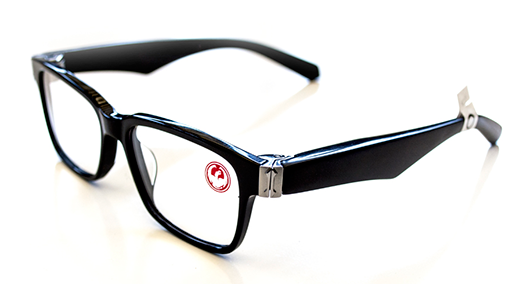Smart-ish Glasses That Don’t Look Dumb
Why wear a special activity-tracking wristband if you can get the same features from the glasses you’ve already got on your face?

VSP Global—whose Marchon eyewear division makes and distributes glasses for brands such as Nike and Calvin Klein—is building glasses that it says can accurately track the wearer’s steps. And unlike Google Glass, the obtrusively in-your-face headgear that Google stopped selling to consumers in January, VSP’s so-called Project Genesis glasses use technology that is mostly hidden.
VSP has been testing an early version of the glasses with employees and soon plans to expand into a pilot with people outside the company in hopes of getting the frames on the market next year, says Jay Sales, co-leader of the VSP research lab working on the project.
The popularity of fitness-tracking wearables like those from Fitbit and Garmin has jumped in the last few years. Recent data from the technology market researcher IDC indicates that shipments of wearable devices tripled during the first three months of 2015, to 11.4 million. Most of them are wristbands.
A lot of people who buy these devices don’t keep them on for long. The tech consulting firm Endeavour Partners recently estimated that one-third of buyers in the United States end up ditching them within six months. The reasons surely vary, but VSP hopes that trackers incorporated into something lots of us are used to wearing every day will be more appealing. And Sales says adding the technology to the frames isn’t expected to make the glasses more expensive for consumers. “We’re hoping this will be ubiquitous in everything we make,” he says.

Sales showed me a prototype: a largely unadorned matte-black frame, built from a Marchon brand called Dragon. The left arm of the glasses contains an accelerometer, a gyroscope, a magnetometer, and a rechargeable battery. They connect via low-energy Bluetooth with a smartphone app that logs steps and derives the number of calories burned, Sales says. Currently, he says, the Project Genesis glasses get about four days of battery life.
I could tell that the left arm was fatter than the right, but overall the glasses didn’t look too unusual—definitely much more like a regular pair of specs than, say, Google Glass (see “Google Glass Is Dead; Long Live Smart Glasses”).
Yet to make Project Genesis appeal to a wide number of glasses-wearing people, VSP will have to overcome several obstacles. The prototype felt weightier than my own sensor-free frames. It’s hard to believe that wouldn’t be annoying, at least at first.
There’s also the issue of how you’ll charge the glasses. Right now, a charger clamps on to two small metal dots located on the inside of the left arm. But Sales doesn’t think this is sufficiently elegant or convenient, especially compared with just taking off the glasses and setting them down. “It took a couple weeks for me to get used to it,” he acknowledges.
Keep Reading
Most Popular
Large language models can do jaw-dropping things. But nobody knows exactly why.
And that's a problem. Figuring it out is one of the biggest scientific puzzles of our time and a crucial step towards controlling more powerful future models.
How scientists traced a mysterious covid case back to six toilets
When wastewater surveillance turns into a hunt for a single infected individual, the ethics get tricky.
The problem with plug-in hybrids? Their drivers.
Plug-in hybrids are often sold as a transition to EVs, but new data from Europe shows we’re still underestimating the emissions they produce.
Stay connected
Get the latest updates from
MIT Technology Review
Discover special offers, top stories, upcoming events, and more.